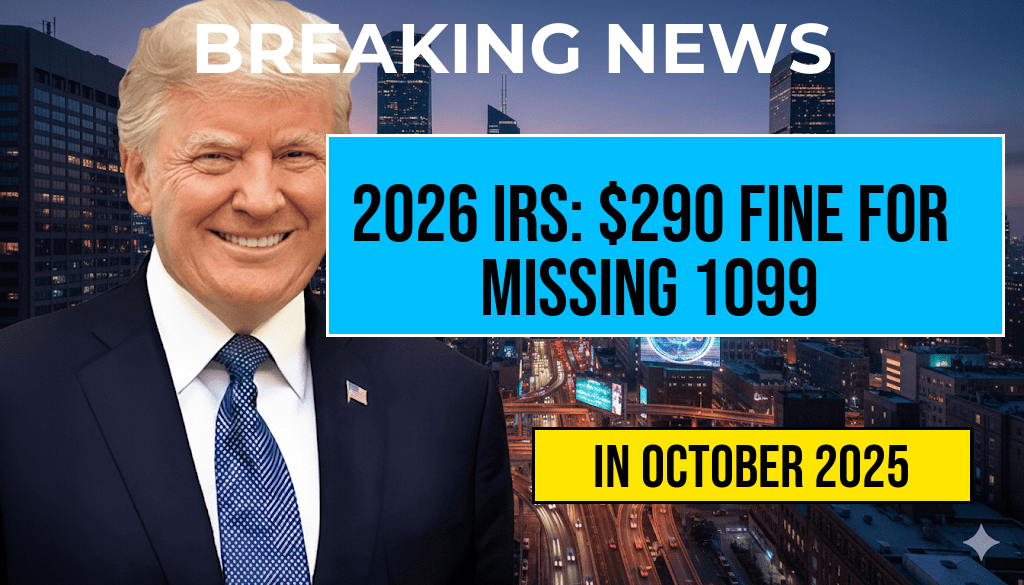Understanding the 2026 IRS Penalties for Missing 1099 Forms
Taxpayers and businesses should prepare for increased penalties starting in 2026 if they fail to file or properly report certain information returns such as the Form 1099. The Internal Revenue Service (IRS) has announced that beginning with the 2026 tax year, penalties for missing or incorrect 1099 filings will significantly increase, with fines reaching up to $290 per form. This change emphasizes the importance of timely and accurate reporting to avoid costly penalties, especially for small businesses, independent contractors, and financial institutions that regularly handle such forms.
Historically, the IRS has imposed penalties for improper or late filings, but recent updates to the tax code and enforcement strategies aim to bolster compliance. The new penalty structure is designed to incentivize accurate reporting and streamline tax enforcement efforts. As the IRS intensifies its focus on information reporting, understanding the scope of these penalties becomes essential for anyone involved in issuing or receiving 1099 forms.
What Are 1099 Forms and Why Are They Important?
Definition and Purpose
The Form 1099 series encompasses several types of information returns used to report various types of income paid to individuals or entities outside of traditional employee wages. The most common variant, Form 1099-NEC, reports payments made to independent contractors, freelancers, and other self-employed individuals. Other variants include 1099-DIV for dividends, 1099-INT for interest income, and 1099-MISC for miscellaneous payments.
Legal Obligation to File
Businesses and payers are legally required to file these forms when they pay $600 or more to a recipient in a calendar year, or in certain other circumstances. The information helps the IRS verify that recipients report their income accurately on their tax returns and ensures compliance with federal tax laws.
2026 Penalty Changes: From Past to Present
| Year | Penalty per Form | Maximum Fine (per Calendar Year) | Notes |
|---|---|---|---|
| 2023 | $50 to $280 | Up to $1.78 million (small business threshold varies) | Based on the level of negligence or intentional disregard |
| 2026 | $290 | Higher caps expected | Proposed increase to enforce compliance and deter non-filing |
*Note: The IRS has not yet published the finalized penalty caps for 2026, but the announced increase in per-form penalties signals tightening enforcement.*
Implications of the Increased Penalties
Financial Impact on Taxpayers and Payers
Payers who neglect to file or submit inaccurate 1099 forms could face fines of up to $290 per omitted or incorrect form. For small businesses issuing dozens of 1099s annually, these penalties can quickly accumulate, reaching thousands of dollars, especially if multiple forms are involved or if the errors are deemed intentional or negligent.
Risk for Independent Contractors and Recipients
Recipients of 1099 forms should also be aware that inaccuracies or late submissions could delay refunds or trigger IRS audits. Ensuring that the information reported matches their records can help prevent discrepancies and potential penalties from the IRS.
Strategies to Avoid Penalties
- Maintain Accurate Records: Regularly update and verify payee information, including Taxpayer Identification Numbers (TINs).
- File on Time: Mark important deadlines and stay ahead of filing schedules to avoid late penalties.
- Utilize Electronic Filing: The IRS encourages electronic submissions, which reduce errors and streamline processing.
- Correct Errors Promptly: If inaccuracies are identified, file corrected forms promptly to mitigate penalties.
- Consult Tax Professionals: Engaging accountants or tax advisors can help ensure compliance with complex reporting requirements.
Legal and Administrative Considerations
The IRS’s increased penalties are part of a broader effort to improve tax compliance through enhanced enforcement. This includes advanced data matching, AI-driven audits, and stricter penalties for intentional disregard of reporting obligations. The agency has also been pushing for increased transparency from payers to prevent underreporting of income.
Taxpayers and businesses should review their current processes for issuing 1099 forms and consider implementing automated systems to track payments and ensure timely filing. With the 2026 deadline approaching, proactive steps can mitigate the risk of costly fines and legal complications.
Resources for Compliance
- IRS Official Guidance on Form 1099
- Forbes: Preparing for IRS 1099 Reporting Requirements
- Wikipedia: Information Return
Frequently Asked Questions
Question
What is the penalty for missing a 2026 IRS 1099 form submission?
Question
How much is the fine per missing 1099 form in 2026?
Question
Who is responsible for submitting 1099 forms to the IRS?
Question
What are the consequences of failing to file a 1099 form on time?
Question
Are there any exceptions or ways to avoid penalties for missing 1099 forms in 2026?

Leave a Reply